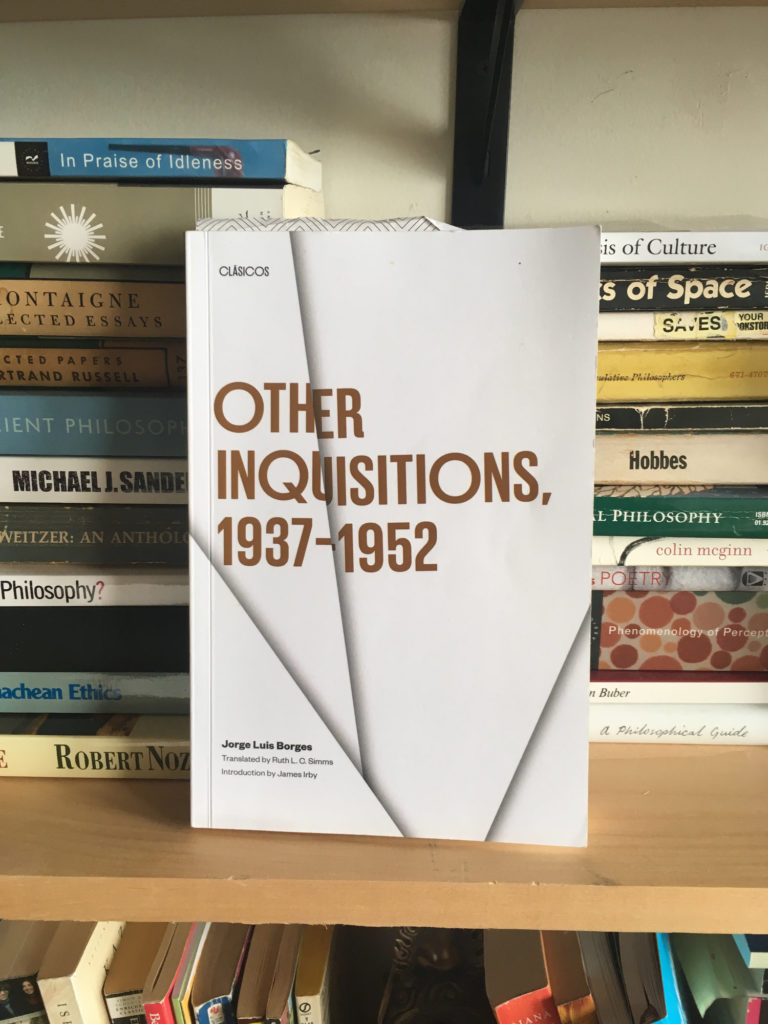
Jerry House mentioned that he loved Other Inquisitions in his comment on Jay Parini’s BORGES AND ME. I read Other Inquisitions in the late 1960s and didn’t fully appreciate it because I hadn’t read many of the books Borges wrote about.
Now, decades later, I reread Other Inquisitions and many of Borges’s essays make a lot more sense because of my years of reading the books he refers to. I took a doctoral seminar on Nathaniel Hawthorne, but Borges’s “Nathaniel Hawthorne” introduces more facts and analysis in just a few pages. That is the genius of Borges: he can distill mountains of books into a pithy essay. Highly recommended! GRADE: A
TABLE OF CONTENTS:
Introduction — ix
The Wall and the Books — 3
Pascal’s Sphere — 6
The Flower of Coleridge — 10
The Dream of Coleridge — 14
Time and J. W. Dunne — 18
The Creation and P. H. Gosse — 22
Dr. Americo Castro is Alarmed — 26
A Note on Carriego — 31
Our Poor Individualism — 33
Quevedo — 36
Partial Enchantments of the Quixote — 43
Nathaniel Hawthorne — 47
Note on Walt Whitman — 66
Valery as a Symbol — 73
The Enigma of Edward FitzGerald — 75
About Oscar Wilde — 79
On Chesterton — 82
The First Wells — 86
The Biathanatos — 89
Pascal — 93
The Meeting in a Dream — 97
The Analytical Language of John Wilkins — 101
Kafka and his Precursors — 106
Avatars of the Tortoise — 109
On the Cult of Books — 116
The Nightingale of Keats — 121
The Mirror of the Enigmas — 125
Two Books — 129
A Comment on August 23, 1944 — 134
About William Beckford’s Vathek — 137
About The Purple Land — 141
From Someone to Nobody — 146
Forms of a Legend — 149
From Allegories to Novels — 154
The Innocence of Layamon — 158
For Bernard Shaw — 163
The Modesty of History — 167
New Refutation of Time — 171
Epilogue — 189
Index — 191
I’ve liked the few Borges things I’ve read, including his Six Problems for Don Isidro Parodi, written with Adolfo Bioy Casares and published as by H. Bustos Domecq.
But I really enjoyed BORGES AND ME: An Encounter (2020) by Jay Parini. It is a delightful book about the young Parini, a grad student and aspiring poet (in 1971), who was tasked by his mentor Alastair Red to drive Borges (of whom he knew only that he was “a visiting Latin American author”) to Scotland and back. It’s a charming memoir and Borges was clearly quite the character.
Jeff, you’re right about BORGES AND ME. Here’s my review: http://georgekelley.org/borges-and-me-by-jay-parini/
Looking for Borges and Me now. I am currently enjoying Sigrid Nunez’ book about Susan Sontag. She lived with her for a while as Sontag’s son’s girlfriend. I am really into documentaries right now too. Just watched one on DuMaurier, which was so interesting.
Patti, I like documentaries, too. Susan Sontag had a huge following among the intelligencia in the Sixties and Seventies with books like AGAINST INTERPRETATION and ILLNESS AS A METAPHOR.
Add an S to Borge, please.
Patti, I added the s.
Which begs the question, who is the Victor?
You intellectuals are all way over my head. My doctoral seminar was on Franklin W. Dixon.
Rick, I’m sure your doctoral dissertation was hardy!
Anyone heard from Deb?
She said she is hunkering down. She’s more worried about the rain than the wind.
Thanks, Jeff. Send along best wishes from us all.
There aren’t too many bad Borges books (till one picks up the inept Penguin translations), but this is one of the few I haven’t looked at again since first reading it in the ’80s, and one I don’t have a copy of. So thanks for the nudge!
Todd, always happy to give you (and others) a nudge toward Good Books!
In the Kabbalah universal history refers to the metaphorical contraction, breakage and restoration that are held to be fully present in all things, events and experiences at all times. These metaphorical ‘moments’constitute the Absolute, the Ein-Sof of God, which is the contradiction of all Absolutes. Just as Borges says: the entire history of the cosmos in just a few metaphors. Borges’s meditation on “More incredible than a celestial flower or the flower of a dream is the flower of the future, the unlikely flower whose atoms now occupy other spaces and have not yet been assembled.”
brist, well said!